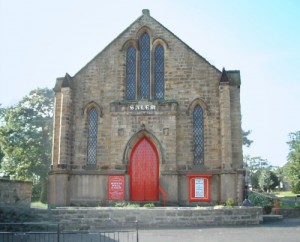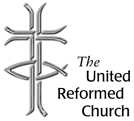Foundation
The Foundation stone of Salem Chapel was laid on Monday the 14th of October 1839 by Mr John Peele Clapham, the  then resident of Burley Hall. At the same time, his wife, Anne, laid the foundation stone of the schoolroom at the other side of the graveyard enclosure, some 50 metres away. Mr J P Pritchett of York was the architect and Mr Burley was the builder.
then resident of Burley Hall. At the same time, his wife, Anne, laid the foundation stone of the schoolroom at the other side of the graveyard enclosure, some 50 metres away. Mr J P Pritchett of York was the architect and Mr Burley was the builder.
The Chapel was officially opened and consecrated on Wednesday the 29th of July 1840. It was established for “the special use of the congregation of Protestant Dissenter of the International Order”.
Salem was officially recognised for the Solemnisation of Marriages on the 11th of March 1842.
Built of local stone in the Pointed Style of the 12th century, the interior of the church originally included a balcony at the rear and a small vestry. The schoolroom was built at the same time. (Sunday school children were then kept separate!)
The whole project took only ten months to complete and cost £1500 (about £175,000 in today’s money) (1990).
When the church opened, the entire complex was free of debts.
The land between the church and school became the graveyard. It was closed to burials in 1896.
Music
The first recollection of a musical instrument to accompany hymns or for playing voluntaries to assist services at Salem is a self-pedalled harmonium. It is not known if this was in place at the opening in 1840.
In 1920 a two-manual full pedal-board organ with German action was acquired from a private house in Rose Bank, Burley, and installed in the church. Originally built in 1911 for the private house, it was rebuilt in Salem by Thos E Hughes, Manningham Organ Works, Bradford. It had 934 speaking pipes (774 of metal and 160 of wood) and several accessories, some of which were quite unusual for organs in England.
Accessories encompassed Piano, Mezzoforte and Fortissimo pistons; free preparation, stops release; wind and crescendo register; balanced crescendo pedals to Swell and Great Organ; Sforzando pedal, bringing the whole of the organ, at the will of the organist, into play from the softest to the loudest combinations.
In 1926 the hydraulic motor was replaced by one driven by electricity.
A major overhaul was needed in 1967. Several pieces of “gadgetry” were disconnected because they were too difficult to repair. The church arranged for a complete overhaul.
Some twenty years on, the instrument was again in a sorry state. On most occasions it was giving sterling service but had become somewhat temperamental. The full rebuild, which it required, was estimated at more than £20,000.
After careful consideration, the church felt it could not justify such an outlay (even if it had the money – which it did not!) and decided to replace the 1920 organ with a modern electronic instrument at the substantially lower cost of £8000.
Shortly before our 150th anniversary weekend in1990, the new Wyvern B230 organ (two manuals and full pedal-board) was installed.
In 2005 a new door was added to the back of the church. This door provides disabled and fire access, as well as quick access into the Park.
